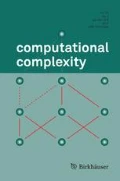Abstract
Certain natural decision problems are known to be intractable because they are complete for E, the class of all problems decidable in exponential time. Lutz recently conjectured that many other seemingly intractable problems are not complete for E, but are intractable nonetheless because they areweakly complete for E (i.e., they are in E and hard for more than a measure 0 subset of E). The main result of this paper shows that Lutz's intuition is at least partially correct: many more problems are weakly complete for E than are complete for E.
The main result of this paper states that weakly complete problems arenot rare in the sense that they form a non-measure 0 subset of E. This extends a recent result of Lutz that establishes the existence of problems that are weakly complete, but not complete, for E. The proof of Lutz's original result employs a sophisticatedmartingale diagonalization argument. Here, we simplify and extend Lutz's argument to prove the main result. This simplified martingale diagonalization argument may be applicable to other questions involving individual weakly complete problems.
Similar content being viewed by others
References
K. Ambos-Spies, S. A. Terwijn, and Zheng Xizhong, resource bounded randomness and weakly complete problems. InProceedings of the Fifth Annual International Symposium on Algorithms and Computation, Springer-Verlag, 1994, 369–377.
J. L. Balcázar, J. Díaz, andJ. Gabarró,Structural Complexity I. Springer-Verlag, Berlin, 1988.
C. H. Bennett andJ. Gill, Relative to a random oracleA, PA≠ NPA≠co-NPA with probability 1.SIAM Journal on Computing 10 (1981), 96–113.
L. Berman, On the structure of complete sets: Almost everywhere complexity and infinitely often speedup. InProceedings of the Seventeenth Annual Symposium on Foundations of Computer Science, IEEE Computer Society Press, 1976, 76–80.
D. W. Juedes andJ. H. Lutz, The complexity and distribution of hard problems.SIAM Journal on Computing 24 (1995), 279–295.
S. M. Kautz and P. B. Miltersen, Relative to a random oracle, NP is not small.Journal of Computer and System Sciences, to appear. See alsoProceedings of the Ninth Structure in Complexity Theory Conference, IEEE Computer Society Press, 1994, 162–174.
A. J. Kfoury, J. Tiuryn, andP. Urzyczyn, An analysis of ML typability.Journal of the ACM 41 (1994), 368–398.
J. H. Lutz, Category and measure in complexity classes.SIAM Journal on Computing 19 (1990), 1100–1131.
J. H. Lutz, Almost everywhere high nonuniform complexity.Journal of Computer and System Sciences 44 (1992), 220–258.
J. H. Lutz, The quantitative structure of exponential time. InProceedings of the Eighth Structure in Complexity Theory Conference, IEEE Computer Society Press, 1993, 158–175.
J. H. Lutz, Weakly hard problems.SIAM Journal on Computing, to appear. See alsoProceedings of the Ninth Structure in Complexity Theory Conference, IEEE Computer Society Press, 1994, 146–161.
J. H. Lutz, Resource-bounded measure. In preparation.
J. H. Lutz andE. Mayordomo, Measure, stochasticity, and the density of hard languages.SIAM Journal on Computing 23 (1994), 762–779.
J. H. Lutz and E. Mayordomo, Cook versus Karp-Levin: Separating completeness notions if NP is not small.Theoretical Computer Science, to appear. See alsoProceedings of the Eleventh Symposium on Theoretical Aspects of Computer Science, Springer-Verlag, 1994, 415–426.
H. G. Mairson, Deciding ML typability is complete for deterministic expontential time. InProceedings of the 17th ACM Symposium on Principles of Programming Languages, ACM Press, January 1990, 382–401.
P. Martin-Löf, On the definition of random sequences.Information and Control 9 (1966), 602–619.
E. Mayordomo, Almost every set in exponential time is P-bi-immune.Theoretical Computer Science 136 (1994), 487–506.
C. P. Schnorr, Klassifikation der Zufallsgesetze nach Komplexität und Ordnung.Z. Wahrscheinlichkeitstheorie verw. Geb. 16 (1970), 1–21.
C. P. Schnorr, A unified approach to the definition of random sequences.Mathematical Systems Theory 5 (1971), 246–258.
C. P. Schnorr, Zufälligkeit und Wahrscheinlichkeit.Lecture Notes in Mathematics 218 (1971).
C. P. Schnorr, Process complexity and effective random tests.Journal of Computer and System Sciences 7 (1973), 376–388.
L. Stockmeyer andA. K. Chandra, Provably difficult combinatorial games.SIAM Journal on Computing 8 (1979), 151–174.
L. J. Stockmeyer, Classifying the computational complexity of problems.Journal of Symbolic Logic 52 (1987), 1–43.


